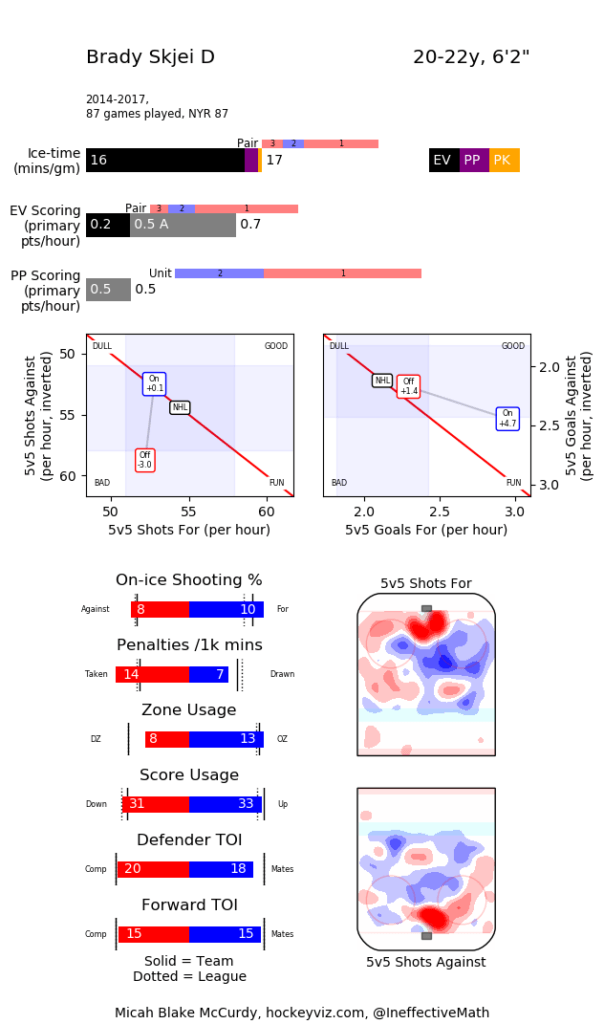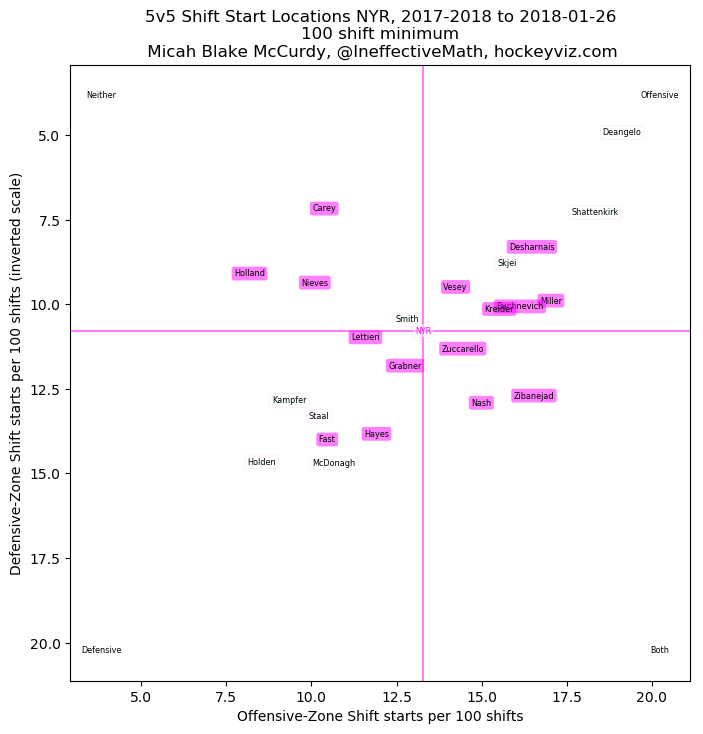Much of the focus the past week is what the Rangers would be able to get for Ryan McDonagh and other players on the roster. However there is still life after the trade deadline, and while trading McDonagh is not a guarantee, there needs to be a contingency plan. The Rangers will need someone to fill in top pairing duties. And by that I mean an actual top pairing defenseman, not another Nick Holden.
The logical step is that Brady Skjei would take that role. He’s already the clear cut #2 on the left side, well ahead of Marc Staal on the depth chart. There aren’t many in the system who could take his role either, so barring a return of a top-pairing defenseman –unlikely at best– we are looking at Skjei assuming the role of top pairing defenseman on the left side.
A big question will be whether or not Skjei can handle the responsibilities of a top pairing defenseman playing in all situations. From a pure skill standpoint, it would certainly be an interesting transition. In a vacuum, Skjei is a better skater and passer than McDonagh, but appears to lack –at least from a reputation standpoint– that #1 defenseman pedigree in his own end. However that is admittedly very flawed analysis, since it only takes into account a season and a half under a coach that likes to ease his youngsters into big time minutes.
There is a lot to digest in the above graphic (which covers this year and last), so let’s keep it simple, looking at the top-third first (the black bars):
- The top bar is Skjei’s ice time. His even strength time accounts for almost all of his ice time. Getting almost no time on special teams at all. Due to that, he barely cracks into average 3rd pairing minutes (the little bar above his ice time bar).
- The middle bar is Skjei’s even strength production. Suffice it to say, he produces offensively at a top pairing rate at even strength. I don’t think that should come as a surprise to anyone.
- The third bar is his powerplay production. He doesn’t play much on the powerplay, so that’s why it looks pretty bad. Plus he –along with basically every Ranger not named Henrik Lundqvist– is having a statistically poor season. Insert your own reason for that here.
Moving to the next section, under the black bars. This section looks at Skjei’s shot and goal rates, compared to the rest of the league:
- The line in the middle is the 50% mark and the black NHL box is league average. Generally speaking, you want the blue ON box, which is how the team performs with him on the ice, to be above the 50% line. The red OFF box is how the team performs without him on the ice.
- Looking at Skjei, the team is clearly better with him on the ice. He doesn’t move the needle much when it comes to shots-for, which is expected given what we know about AV’s quality over quantity system. However when he’s off the ice, the team is far worse when allowing shots.
- That right plot is goal rates. When he’s on the ice, the team produces a lot more. Again, not surprising. What is worth noting is that when he’s off the ice, the team also scores a little more, albeit not as much as when he’s on the ice. I read this as he drives offense when on the ice, more than the team average. The team itself also scores a lot in general. Skjei has a large impact in that.
The bottom third is split into halves. Let’s look at the left half, each bar means something different.
- The team shoots 10% while Skjei is on the ice, above league average. Their opponents shoot 8% when he is on the ice, roughly average. I read this as Skjei helps drive offense with his solid passing, creating better opportunities. Defensively, he isn’t necessarily a liability, but he’s not a stalwart.
- The next bar is how many penalties Skjei personally takes/draws while on the ice. That’s easy to read, and is certainly an area for Skjei to improve.
- The third bar is zone usage – Skjei gets most of his starts in the offensive zone. More on that below.
- The fourth bar is Skjei’s usage based on score situation. He’s used both when up or down, and there isn’t much of a lean in either direction. Balanced usage based on score.
- The last two graphs show quality of competition faced and teammates played with. Generally speaking, Skjei faces better blue liners than he plays with (not surprising) and doesn’t face tough forward competition (also not surprising.
The entire Blueshirts team hemorrhages shots, so I’m basically ignoring the remainder of the graphic because it doesn’t paint a true picture. It looks a lot worse than it is, but it is very difficult to separate the system from the player’s results.
So what does all this mean?
The above graphic and analysis shows us that Skjei is excelling in his current role. While we all lament about AV’s refusal to play true rookies consistently, Skjei’s growth under AV is a bright spot for the coach. If Skjei doesn’t develop into a successful 2LD/top-four, do the Rangers explore a McDonagh trade?
But while the big question is whether or not Skjei can handle those responsibilities, the real question is whether or not Skjei can handle those responsibilities in an Alain Vigneault system. That’s the rub, since AV doesn’t use new-age logic in his deployments. His top pair is his shutdown pair, for better or for worse.
Skjei’s deployment has been far from the “traditional” use of top pairing defensemen, though, at least per what we see from AV. He’s getting primarily offensive zone starts. That’s not necessarily indicative of his defensive zone play, just how AV uses him. Taking a step back and looking at the personnel on the blue line, Skjei is one of two guys (outside of McDonagh) who can actually handle the puck. So he’s being put in a spot to succeed. That’s fine for now. But again, how would he fare when those starts shift to the defensive zone?
That last question is nearly impossible to answer without seeing him play those minutes. However from what we’ve seen in his first season and a half, and what we can infer from the stats, it appears Skjei would be just fine in that role.
One last tool to use to help predict whether or not Skjei can succeed as a top pairing defenseman. This is how Skjei’s current production compares to the average top defender on a team. The ice time would certainly change, and with more ice time comes more counting stats to pad his phenomenal rate scoring stats. The concern for me would be his shot generation. However I am still of the belief that is system related, as the Rangers choose quality over quantity. The jury is still out on that, though.
The overall body of work for Brady Skjei is pretty impressive. He’s succeeded in his role as a 2LD and top four defenseman. His success hasn’t necessarily fueled the McDonagh trade rumors, but it will make any trade, if one happens, easier to manage. We don’t know if Skjei will succeed as a 1D on this team, but he’s earned a shot.
Share:
More About:Players




